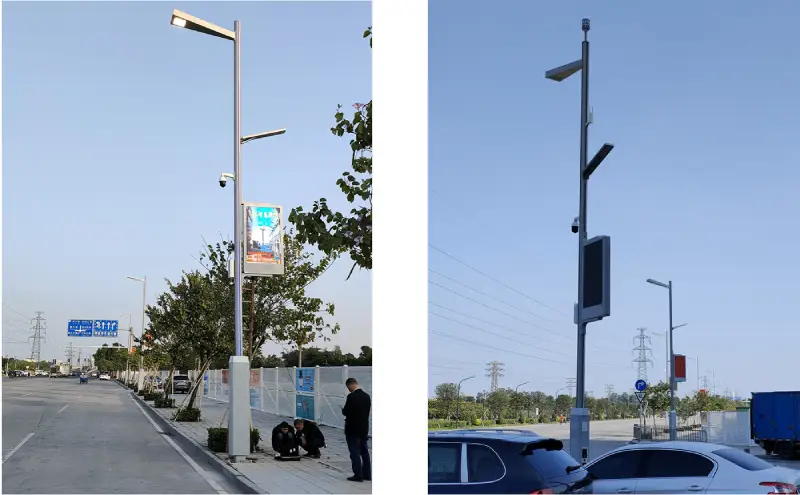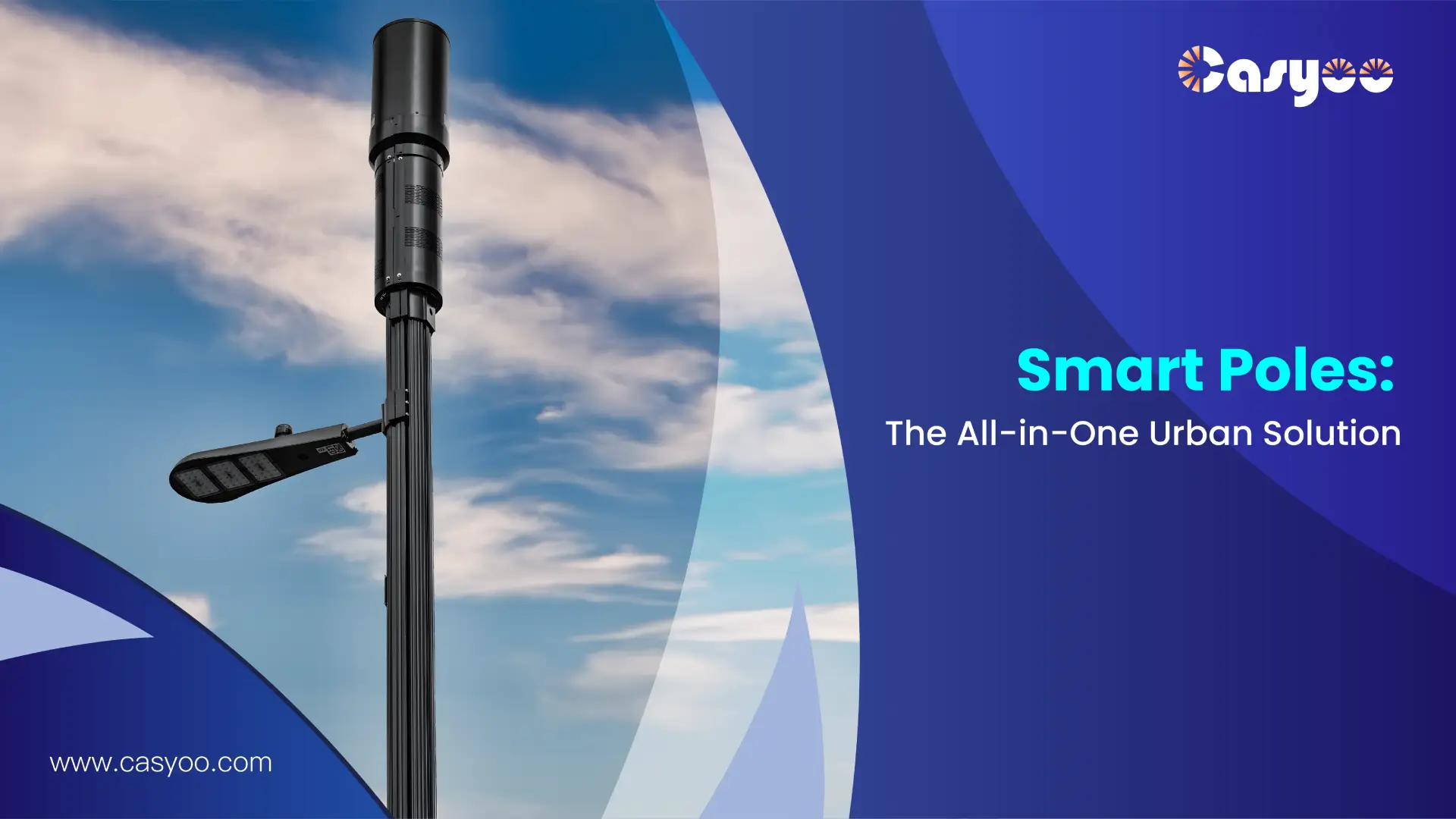Imagine this: It’s nightfall and you’re strolling down a city street. In perfect harmony with the diminishing natural light, the street lights automatically turn down. Using the same pole that lights your path, your phone easily connects to high-speed internet. In the meantime, these poles’ environmental sensors are silently keeping an eye on the quality of the air, assisting municipal planners in making well-informed judgments on traffic flow. This isn’t a scene from a science fiction film; smart poles are a reality and are currently transforming our urban environments.
The Urban Infrastructure Revolution: Why Cities Are Embracing Smart Poles
I have worked on urban infrastructure projects for more than seven years as an LED lighting engineer, and I have seen firsthand the significant problems that contemporary cities face. While old lighting infrastructure necessitates ongoing repair, rising energy costs are placing a burden on municipal finances. With limited resources, cities are finding it difficult to maintain public safety, efficiently monitor air quality, and provide dependable internet connectivity in crowded urban areas. Conventional street lights are ill-equipped to handle these complex issues, yet they account for a significant portion of a city’s electrical budget.
Here, smart poles show up as a game-changing remedy. These smart buildings are transforming urban infrastructure by fusing energy-efficient LED lighting with cutting-edge technologies like security systems, 5G connectivity, and environmental sensors. The market is responding positively to this innovation; industry reports predict that the global smart pole market will grow at a compound annual rate of more than 19% through 2028, driven by cities’ efforts to improve sustainability, lower operating costs, and raise residents’ living standards.
Understanding Smart Poles: Beyond Simple Illumination
Core Definition and Basic Components
Smart poles are used for much more than just street illumination. They are modular infrastructure hubs that integrate energy-efficient LED lighting with a variety of smart technologies, making them digital Swiss Army knives for contemporary cities. Any smart pole’s cutting-edge LED lighting system is its cornerstone, but these intricate constructions are capable of much more.
Key Features and Capabilities
An energy-efficient LED fixture, which can cut power usage by up to 50–80% when compared to conventional lighting options, is usually part of the core system. Lower operating expenses and fewer carbon emissions are directly correlated with this large energy usage reduction. But when we incorporate other technology, the true magic occurs.
LED Lighting System’s Energy Advantages
The energy consumption of contemporary LED lighting fixtures in smart poles is significantly lower than that of conventional lighting systems. Smart LED poles offer better illumination quality and can save up to 75% on energy expenses.
ROI Benefits for Cities and Businesses
The adoption of smart poles offers a compelling return on investment. With energy savings alone, cities usually recoup their initial expenditure in three to five years. The financial advantages become much more alluring when lower maintenance costs and possible income from services like EV charging or hosting 5G infrastructure are taken into account.
Retrofit Possibilities for Existing Infrastructure
Retrofitting existing street lights is one of the most useful features of smart pole technology. Through smart retrofitting projects, cities can enhance their lighting systems over time without having to rebuild their entire infrastructure at once.
Technical Innovation in LED Smart Pole Technology
Energy Efficiency Metrics
Urban lighting has advanced significantly thanks to the LED lighting systems in smart poles. Colors appear more realistic and natural at night because to modern LED lighting that may reach color rendering indexes (CRI) above 80. Metrics of power consumption reveal up to 80% improvement over conventional lighting systems.
Intelligent Dimming Capabilities
These systems’ clever dimming features allow them to automatically modify their output in response to preset schedules or ambient light levels. More energy efficiency can be achieved by using sophisticated sensors that can recognize movement and modify lighting settings accordingly.
Color Temperature Control
With the help of dynamic color temperature regulation, smart poles may switch between warm and cold white light (usually between 2700K and 6500K) to accommodate human circadian rhythms and improve visibility in various situations.
Lifespan Advantages
High-quality LED lights can last between 50,000 and 100,000 hours, which drastically lowers the need for maintenance and replacement expenses. Their long lifespan and energy efficiency make them an extremely economical option.
Integrated Technologies
Smart poles can be used for much more than just lights. Multiple technologies can be housed in modern poles, converting them into all-inclusive urban service platforms.
5G/WiFi Capabilities
Smart poles provide essential infrastructure for next-generation wireless networks by acting as perfect mounting locations for WiFi access points and 5G small cells. These poles’ thoughtful positioning contributes to the smooth interconnectedness of cities.
Environmental Sensors
Advanced environmental monitoring systems can track:
- Air quality indicators (PM2.5, CO2, NOx)
- Noise levels
- Temperature and humidity
- UV index
- Rainfall and wind conditions
Security Cameras
High-definition security cameras include cutting-edge technologies such as automatic incident detection and facial recognition to increase public safety. Security staff can adhere to rigorous privacy guidelines when integrating these technologies with citywide security networks.
Digital Displays
Interactive digital displays can provide real-time information about:
- Weather conditions
- Traffic updates
- Public transportation schedules
- Emergency notifications
- Local events and announcements
EV Charging Options
Smart poles are converted into practical charging stations for the increasing number of electric vehicles through integrated electric vehicle charging stations, promoting sustainable urban mobility.

The 5G Revolution in Smart Poles
Integration Capabilities
It’s especially thrilling to see 5G technology integrated into smart poles. These poles help provide the dense coverage required for 5G deployment by acting as perfect mounting locations for small cell networks. Smart poles are ideal locations for 5G equipment due to their height and pre-existing power infrastructure, and their attractive design lessens the visual impact on the cityscape.
Coverage Benefits
Urban connectivity is being transformed by smart pole networks in ways that were unthinkable only a few years ago. These clever buildings accommodate thousands of devices at once by establishing a smooth network of fast connectivity in crowded cities. In crowded metropolitan locations, smart poles positioned strategically can cut down on network dead zones by as much as 90%. From uninterrupted IoT device connection throughout the cityscape to seamless video streaming during rush hour, the impact on user experience is astounding.
Smart poles’ ideal height and spacing are what make them especially useful for urban connectivity. In the urban canyons formed by tall buildings, traditional cell towers frequently have trouble providing reliable coverage. Smart poles, on the other hand, build a more granular network that guarantees consistent signal strength even in difficult urban settings. The end effect is a more responsive and dependable network that can handle everything from essential emergency communications to light smartphone use.
Safety Considerations
Security and privacy of data are critical while implementing smart poles. Modern systems employ end-to-end encryption and robust authentication processes to protect sensitive data. These systems are kept safe from new threats by routine security audits and updates.
Future Connectivity Potential
Smart pole technology has a lot more uses in the future than it does now. Smart poles will be essential navigation signals as autonomous vehicles proliferate, offering real-time information on road dangers, weather, and traffic conditions. For safe autonomous vehicle operation in urban settings, smart poles’ high-precision locating capabilities will be crucial.
Furthermore, emergency response systems could undergo a revolution because to these intelligent architectures. Consider a system of intelligent poles that can automatically identify events, like as traffic jams or medical crises, and coordinate prompt action. Several locations are currently deploying AI-powered systems that can evaluate camera feeds and sensor data to identify potential safety issues before they become serious problems.
The introduction of sophisticated IoT capabilities will enable new urban service delivery models. Smart poles will enhance the quality of life for citizens while assisting cities in operating more efficiently through automated maintenance scheduling and dynamic resource allocation. These flexible platforms will change to accommodate new uses that we haven’t even thought of yet as technology advances.
Sustainability and Environmental Impact
Smart poles have significant and quantifiable environmental advantages. By switching to smart LED poles, a mid-sized city can drastically cut its carbon emissions. Modern smart poles are frequently made of recyclable sophisticated materials, which supports the circular economy approach to urban infrastructure.
For environmental scientists and city planners, environmental monitoring skills offer useful data. By monitoring air quality indicators, these poles assist cities in locating areas of high pollution and putting focused remedies in place. In order to improve local weather forecasting, some systems even incorporate weather monitoring stations.
Real-World Applications and Success Stories
Tvilight, a smart lighting system in Amsterdam, only turns on when there are automobiles, bicycles, or pedestrians around. The I-Core smart pole, created by the Singaporean company Technolite, was tested in 2019 at Sentosa’s Palawan Beach. These smart poles support a variety of tasks, including street lighting, communication and connectivity, security monitoring, and traffic management. In addition to providing lighting, they have specific sections for Internet of Things devices that gather data on things like light intensity, noise levels, and visitor foot traffic.
For long-term success, maintenance concerns are essential. Because of its modular architecture, smart poles enable the upgrading or replacement of individual parts without affecting the system as a whole. Routine maintenance plans should include sensor calibration, network security upgrades, and LED performance assessments.
Future Outlook
It appears that smart poles have a very bright future. Emerging technologies like artificial intelligence and machine learning will enhance their capabilities and enable more sophisticated reactions to environmental factors and user needs. Future plans call for integration with driverless cars, with smart poles possibly acting as charging stations and navigation beacons.
Frequently Asked Questions
What is the lifespan of an LED light pole?
When properly maintained, high-quality LED lights in smart poles can last anywhere from 50,000 to 100,000 hours under average working conditions.
What kinds of light poles are there?
Smart poles are available in a range of configurations, from entry-level ones with sensors and LED lights to more sophisticated models with digital displays, 5G, and EV charging.
What is the price of building a light pole?
From low-cost smart poles to high-end ones with extensive feature sets, the price varies greatly depending on features and capabilities. Contact us for a detailed quote that is customized to meet your needs.
Start Your Smart City Journey Today
One step begins the process of turning a city into a smart one. Let our experienced personnel help you modernize the infrastructure in your community. We’ll be there to make sure your smart pole network provides the performance, dependability, and security your community expects from the very beginning to the very end of deployment. To begin your journey toward a more sustainable, connected, and efficient urban future, schedule a consultation with us right now.




